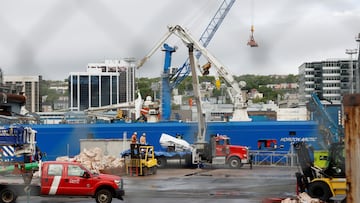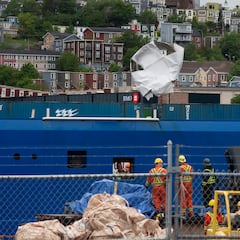Expert offers theory on how Titan tragedy might have unfolded
In a report for the Spanish outlet NIUS, José Luis Martín has used the information currently available to put together a timeline of how the Titan tragedy may have happened.

A Spanish expert in underwater vessels has pieced together a potential sequence of events that led to the Titan’s tragedy.
Using the information released so far about the accident, which took place on 18 June as the submersible dove towards the wreckage of the Titanic, the engineer José Luis Martín has suggested that an electrical fault unleashed a chain reaction that caused the craft to implode.
Built and operated by the company OceanGate Expeditions, the Titan lost contact with its support ship, the Polar Prince, an hour and 45 minutes after setting off towards the Titanic, which is 12,500 feet below the surface of the Atlantic Ocean, just under 400 miles off the coast of Newfoundland, Canada.
Debris from the Titan was discovered four days later, the US Coast Guard confirming that the submersible is believed to have suffered a “catastrophic implosion”, killing all five people on board. Parts of the vessel were brought ashore in Newfoundland this week, with the US Coast Guard revealing that “presumed human remains” were among the debris.
Titan implosion: expert’s timeline of events
In a report put together for the Spanish media outlet NIUS, Martín says weight distribution is likely to have played a key role in the Titan’s implosion.
“During the controlled immersion of the Titan, there must have been an electrical fault, which left the craft without thrust,” he writes. “Without thrust, the weight of the passengers and the pilot (about 400 kilograms), which was focused on the front end close to the view port, would have disrupted the Titan’s longitudinal stability.” Martín believes that this took place at a depth of around 5,500 feet.
“At this point, the submersible begins to fall headlong towards the seafloor, and with control and safety functions damaged it can no longer be maneuvered,” Martín theorises. “The pilot couldn’t activate the emergency leaver to drop weights [and return to the surface].” According to NIUS, the expert believes the emergency leaver was an inadequate mechanism for a critical situation.
“As it fell to the depths of the ocean, the hull would have been subjected to a sudden increase in underwater pressure”, Martín says, leading to a “powerful compression” of the craft’s shell.
The rapid contraction of the Titan’s hull, which was made from carbon fibre, “would have been out of step with what was happening to the [acrylic] material of the view port, which has different characteristics. As their processes of deformation were different, this would have created a micro-fissure, allowing water in at such a level of pressure that it brought about an instantaneous implosion.”
Related stories
The implosion, at about 9,000 feet below the surface, would have killed the Titan’s occupants instantly, Martín adds.
Titan tragedy: live coverage
You can follow the latest updates on the aftermath of the Titan tragedy with AS USA’s live blog.
Video - Titan debris brought ashore:


